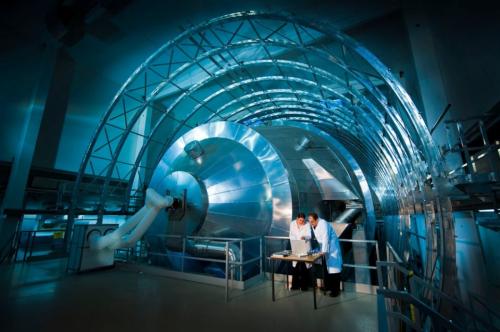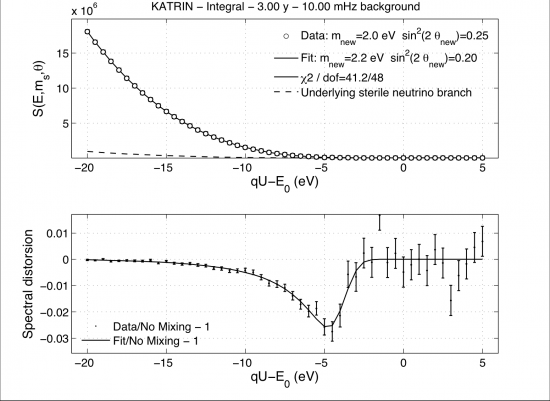
Main spectrometer selecting the electrons close to the endpoint energy of the tritium beta decay (18.575 keV). Credit: KATRIN Collaboration.
The KATRIN experiment
Neutrinos are the most abundant matter particles of the Universe, but also the lightest! In 2015 the Nobel prize was awarded for the discovery of neutrino oscillations, which shows that neutrinos have mass. Their tiny mass is a compelling evidence for physics beyond the standard model of elementary particle physics.
The absolute value of the neutrino masses is very important in understanding, which of the possible extensions or new theories beyond the Standard Model of particle physics is the right one. In addition it is highly relevant for astrophysics and cosmology, because of the role of neutrinos in the formation of structures in the Universe.
The current best laboratory upper limit to the electron anti-neutrino mass is 2.3 eV/c2, by former experiments at Mainz and Troitsk. KATRIN will use similar techniques to improve the sensitivity by one order of magnitude down to 0.2 eV/c2 (90% CL) or to discover the actual mass, if it is larger than 0.35 eV/c2. This requires an improvement by two orders of the detector systematic uncertainties.
The KArlsruhe TRItium Neutrino (KATRIN) experiment will investigate the absolute mass scale of electron neutrinos. The experimental setup is currently being commissioned at Tritium Laboratory Karlsruhe on the KIT Campus North site. KATRIN is designed to achieve an overall neutrino mass sensitivity of 200 meV at 90% C.L. after 3 years of data taking. The international KATRIN Collaboration consists of more than 150 scientists, engineers, technicians and students from 12 institutions in Germany, the United Kingdom, the Russian Federation, the Czech Republic, the United States, and France via the participation of CEA.
Direct measurement of the neutrino mass
The direct neutrino mass determination is based purely on kinematics without further assumptions. Essentially, the neutrino mass is determined by using the relativistic energy-momentum relationship E2 = p2 + m2. Therefore it is sensitive to the neutrino mass squared m2. In KATRIN the measurement of the neutrino mass is done through the investigation of the endpoint region of the tritium β-decay spectrum. It is currently the most sensitive model-independent and direct method to determine the absolute neutrino mass scale. The neutrino is not observed but the tail of the electron spectrum is precisely measured. Using energy and momentum conservation the neutrino mass can be obtained.

Contribution of a hypothetical sterile neutrino to theend point of the tritium beta-decay spectrum (top). Ratio of spectra with and without light sterile neutrinos (bottom). Credit: Th. Lasserre.
Search for light sterile neutrinos
A new neutrino heavier than the three active neutrinos should leave an imprint in the KATRIN tritium β-spectrum. The detection principle is to search for a distortion at the high energy endpoint of the electron spectrum of tritium β-decay, since its shape is a priori well understood within the 3-neutrino mixing framework. Any shape distortion due to decays involving an heavier neutrino could sign the existence of a sterile neutrino state.
As designed the KATRIN experiment can probe part of the current allowed region of the reactor antineutrino anomaly, especially for ?m2 greater than a few eV2 , with 3 years of data-taking. First results are expected in 2017.
The KATRIN setup
KATRIN aims as measuring precisely the high energy tail of the tritium β-decay spectrum by combining an intense molecular tritium source with an integrating high-resolution spectrometer.
The overall components of the experiment include:
(a) A rear section, used for calibrating the response of the detector and monitoring the source strength during the run of the experiment,
(b) A Windowless Gaseous Tritium Source (WGTS), where 1011 electrons are produced per second by the decay of molecular high-purity tritium gas at a temperature of 30 K,
(c) An electron transport and tritium elimination section, comprising an active differential pumping (DPS) followed by a passive cryo-pumping section (CPS), where the tritium flow is reduced by more than 14 orders of magnitude,
(d) The electrostatic pre-spectrometer of MAC-E-Filter type, which offers the option to pre-filter the low-energy part of the tritium decay spectrum,
(e) The large electrostatic main spectrometer of MAC-E-Filter type which represents the precision energy filter for electrons,
(f) A segmented Si-PIN diode array to count the transmitted electrons.
Status of the experiment
On October 14th an important milestone was accomplished on the way to measuring the neutrino mass, the "first light", i.e. when the detector first sees electrons that have passed through the entire 70-meter-long KATRIN setup.
